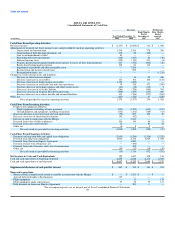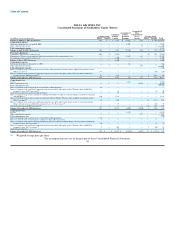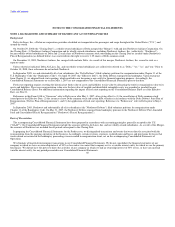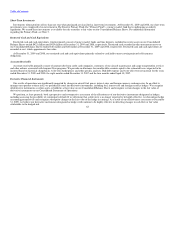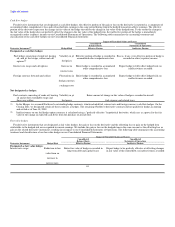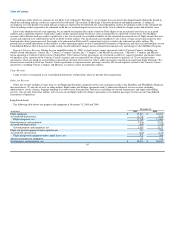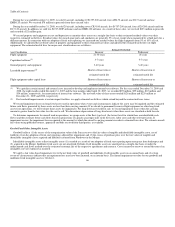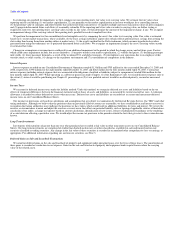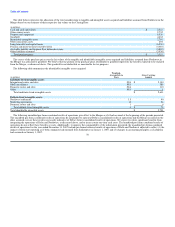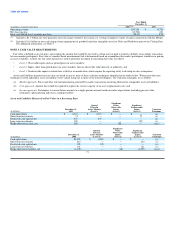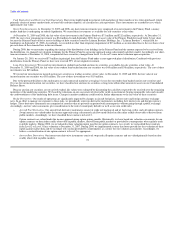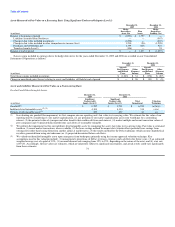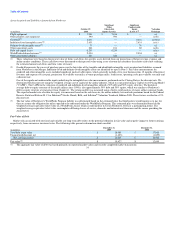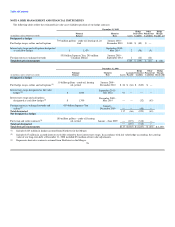Delta Airlines 2009 Annual Report Download - page 71
Download and view the complete annual report
Please find page 71 of the 2009 Delta Airlines annual report below. You can navigate through the pages in the report by either clicking on the pages listed below, or by using the keyword search tool below to find specific information within the annual report.
Table of Contents
During the year ended December 31, 2009, we sold 16 aircraft, including 10 B-757-200 aircraft, four ATR-72 aircraft, one DC-9 aircraft and one
EMB-120 aircraft. We received $78 million in proceeds from these aircraft sales.
During the year ended December 31, 2008, we sold 20 aircraft, including seven CRJ-100 aircraft, five B-757-200 aircraft, four A320-200 aircraft and four
DC-9-30 aircraft. In addition, we sold two B-747-200F airframes and one EMB-120 airframe. As a result of these sales, we received $123 million in proceeds
and recorded a $21 million gain.
We record property and equipment at cost and depreciate or amortize these assets on a straight-line basis to their estimated residual values over their
respective estimated useful lives. Residual values for owned spare parts and simulators are generally 5% of cost except when guaranteed by a third party for a
different amount. In connection with our adoption of fresh start reporting, we increased our residual values for flight equipment from 5% to 10% of cost.
Additionally, we adjusted the net book values of property and equipment to their estimated fair values and adjusted the estimated useful lives of flight
equipment. The estimated useful lives for major asset classifications are as follows:
Estimated Useful Life
Asset Classification Successor Predecessor
Flight equipment 21-30 years 25 years
Capitalized software(1) 3-7 years 5-7 years
Ground property and equipment 3-40 years 3-40 years
Leasehold improvements(2)
Shorter of lease term or
estimated useful life
Shorter of lease term or
estimated useful life
Flight equipment under capital lease
Shorter of lease term or
estimated useful life
Shorter of lease term or
estimated useful life
(1) We capitalize certain internal and external costs incurred to develop and implement internal-use software. For the years ended December 31, 2009 and
2008, the eight months ended December 31, 2007 and the four months ended April 30, 2007, we recorded $95 million, $99 million, $67 million and
$34 million, respectively, for amortization of internal-use software. The net book value of these assets totaled $126 million and $229 million at
December 31, 2009 and 2008, respectively.
(2) For leasehold improvements at certain airport facilities, we apply estimated useful lives which extend beyond the contractual lease terms.
We record impairment losses on long-lived assets used in operations when events and circumstances indicate the assets may be impaired and the estimated
future cash flows generated by those assets are less than their carrying amounts. If we decide to permanently remove flight equipment or other long-lived
assets from operations, we will evaluate those assets for impairment. For long-lived assets held for sale, we record impairment losses when the carrying
amount is greater than the fair value less the cost to sell. We discontinue depreciation of long-lived assets when these assets are classified as held for sale.
To determine impairments for aircraft used in operations, we group assets at the fleet-type level (the lowest level for which there are identifiable cash
flows) and then estimate future cash flows based on projections of capacity, passenger mile yield, fuel costs, labor costs and other relevant factors. If
impairment occurs, the impairment loss recognized is the amount by which the aircraft's carrying amount exceeds its estimated fair value. We estimate aircraft
fair values using published sources, appraisals and bids received from third parties, as available.
Goodwill and Other Intangible Assets
Goodwill reflects (1) the excess of the reorganization value of the Successor over the fair values of tangible and identifiable intangible assets, net of
liabilities, from the adoption of fresh start reporting, adjusted for impairment and (2) the excess of purchase price over the fair values of tangible and
identifiable intangible assets acquired and liabilities assumed from Northwest in the Merger.
Identifiable intangible assets reflect intangible assets (1) recorded as a result of our adoption of fresh start reporting upon emergence from bankruptcy and
(2) acquired in the Merger. Indefinite-lived assets are not amortized. Definite-lived intangible assets are amortized on a straight-line basis or under the
undiscounted cash flows method over the estimated economic life of the respective agreements and contracts. Costs incurred to renew or extend the term of an
intangible asset are expensed as incurred.
We apply a fair value-based impairment test to the net book value of goodwill and indefinite-lived intangible assets on an annual basis and, if certain
events or circumstances indicate that an impairment loss may have been incurred, on an interim basis. The annual impairment test date for our goodwill and
indefinite-lived intangible assets is October 1. 66




